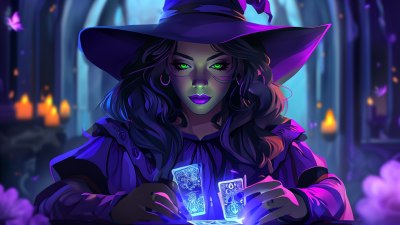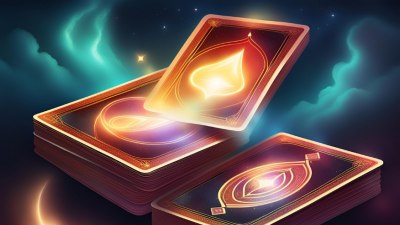How to Use Tarot Cards to Get Answers 🔮✨
Learn how to use tarot cards to get answers and guidance in your life. Discover tarot spreads, how to interpret the cards, and tips for asking the right questions to gain clarity and insight!

This image was created with the assistance of Playground AI
Tarot cards are a powerful tool for self-reflection, guidance, and gaining answers to your most pressing questions. While often associated with fortune-telling, tarot’s true magic lies in its ability to tap into your intuition and provide insights into your life, decisions, and future paths.
Whether you’re new to tarot or looking to deepen your practice, learning how to use tarot cards to get clear answers can help you find clarity and direction in any situation. Let’s dive into how to use tarot for guidance and unlock the wisdom of the cards.
Step 1: Set Your Intention and Focus Your Energy 🎯
Before pulling any cards, it’s important to get clear on what you want to ask or understand. Tarot works best when your mind is focused and your energy is aligned with your intention. This helps you receive the most accurate and relevant guidance.
- How to do it: Take a few deep breaths, center yourself, and reflect on the question or situation you want guidance on. Be specific, but open to whatever answers the cards provide.
Example Questions:
- “What should I focus on to improve my career?”
- “What do I need to know about this relationship?”
- “What is blocking my path to success?”
Tip: Avoid yes/no questions. Tarot is about exploring possibilities and providing deeper insights, so open-ended questions work best.
Step 2: Choose the Right Spread 🃏
The way you lay out the cards—known as a spread—helps provide structure to your reading and organizes the answers in a meaningful way. There are many tarot spreads to choose from, depending on what kind of guidance you're seeking.
Here are some common tarot spreads to get you started:
1. The One-Card Pull 🃏
- Best for: Simple, quick answers to focused questions.
How to use it: Shuffle your tarot deck and pull one card. The message from this card can offer clarity on your question or give you insight into your current energy. This is great for daily guidance or when you’re short on time.
2. The Three-Card Spread 🃏🃏🃏
- Best for: Understanding the past, present, and future of a situation.
How to use it: Shuffle the deck and pull three cards. Lay them out in a row:
- Card 1: Represents the past influences.
- Card 2: Represents the present situation.
- Card 3: Represents the future outcome or advice.
This spread is perfect for gaining perspective on how a situation has evolved and what’s likely to happen next.
3. The Celtic Cross Spread 🃏✴️
- Best for: Deep insights into complex questions or situations.
How to use it: The Celtic Cross is one of the most detailed tarot spreads and consists of 10 cards, each representing different aspects of the situation. This spread covers everything from current influences, challenges, subconscious feelings, and potential outcomes. It’s ideal for when you need a thorough reading on a complicated issue.
Step 3: Shuffle and Draw the Cards 🔄
Once you’ve chosen your spread, it’s time to shuffle the cards. The act of shuffling connects your energy with the deck and aligns the cards with your question.
- How to shuffle: There’s no right or wrong way to shuffle tarot cards—do what feels natural to you. You can cut the deck in different ways, shuffle in your hands, or spread the cards out on a surface and swirl them around.
While shuffling, focus on your question and let your intuition guide you. When you feel ready, stop shuffling and draw the cards for your chosen spread.
Tip: If a card “jumps” out while shuffling, take note of it. Some tarot readers believe that cards that fly out during a shuffle carry extra meaning.
Step 4: Interpret the Cards and Their Messages 🔮
Once your cards are laid out, it’s time to interpret their meanings. Each tarot card carries symbolic imagery and messages that can help you gain insight into your question. The meaning of the cards can vary depending on their position in the spread and the context of your question.
Key Tips for Interpreting Tarot Cards:
- Pay attention to the imagery: The visual symbolism on the cards often holds clues to the answer. Notice what stands out to you and how the imagery relates to your question.
- Consider the card’s traditional meaning: Each tarot card has a traditional meaning, which you can use as a foundation for interpretation. For example, the Fool represents new beginnings, the Tower represents sudden change, and the Sun represents success and happiness.
- Use intuition: Tarot is deeply intuitive, so trust your gut feelings as you interpret the cards. What emotions, thoughts, or insights arise when you look at the cards? Sometimes, the meaning is more about how the card makes you feel than its traditional interpretation.
Example: If you pull the Chariot card while asking about your career, it could indicate that you’re in control of your direction and have the power to push forward successfully.
Step 5: Reflect and Apply the Message 📝
After you’ve interpreted the cards, take some time to reflect on their messages. How do they relate to your current situation or question? Tarot readings are not always about predicting the future but rather helping you gain clarity about what’s happening in your life and guiding you toward the best course of action.
- Journaling: Write down your question, the cards you drew, and your interpretation. Over time, you can look back at your tarot journal to see how the readings have guided you.
- Take action: Tarot provides insights, but it’s up to you to take action based on the messages you receive. If the cards show you a new path or challenge, consider what steps you can take to navigate the situation.
Tip: Tarot isn’t about fate being set in stone. It’s about empowering you with knowledge and helping you make informed decisions.
How to Ask the Right Questions for Tarot Guidance 🎙️
The types of questions you ask greatly influence the clarity and depth of your tarot reading. Here are some tips for crafting effective tarot questions:
- Focus on open-ended questions: Rather than asking “Will I get the job?” ask “What steps can I take to improve my chances of getting the job?” Open-ended questions allow for deeper, more insightful guidance.
- Avoid yes/no questions: Tarot shines when it provides context and deeper understanding. Instead of asking “Should I move to a new city?” ask “What do I need to know about moving to a new city?”
- Ask about the journey, not just the outcome: Tarot is a tool for personal growth, so questions that focus on how to navigate a situation or learn from it tend to yield the most helpful results.
Example Questions:
- “What can I do to improve my relationship with [name]?”
- “What challenges do I need to overcome in my career?”
- “How can I align more with my life purpose?”
Final Thoughts: Using Tarot for Guidance and Clarity ✨
Tarot is a powerful tool for self-reflection, offering insights that help you navigate life’s challenges and opportunities with greater clarity. Whether you’re seeking answers about love, career, or personal growth, tarot provides a window into the deeper energies at play in your life. By setting clear intentions, choosing the right spread, and trusting your intuition, you can use tarot to unlock the wisdom of the universe and gain the answers you need.























